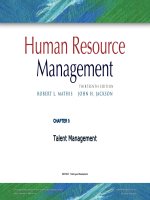Human resrouce management 13th mathis jacson chapter 010
Bạn đang xem bản rút gọn của tài liệu. Xem và tải ngay bản đầy đủ của tài liệu tại đây (1.77 MB, 42 trang )
CHAPTER 10
Performance Management
and Appraisal
SECTION 3 Training and Development
© 2011 Cengage Learning. All rights reserved. May not be
scanned, copied or duplicated, or posted to a publicly
accessible Web site, in whole or in part.
PowerPoint Presentation by Charlie Cook
The University of West Alabama
Chapter Objectives
After you have read this chapter, you should be able to:
• Identify the components of performance management systems.
• Distinguish between performance management and performance
appraisal.
• Explain the differences between administrative and developmental
uses of performance appraisal.
• Describe the advantages and disadvantages of multisource (360degree) appraisals.
• Discuss the importance of training managers and employees about
performance appraisal, and give examples of rater errors.
• Identify several concerns about appraisal feedback and ways to
make it more effective.
The Nature of Performance Management
Make clear what the
organization expects
Provide performance
information to
employees
Effective
Performance
Management
System
Identify areas of
success and needed
development
Document
performance for
personnel records
Performance Management versus
Performance Appraisal
Performance Management
Performance Appraisal
Processes used to identify,
encourage, measure,
evaluate, improve, and
reward employee
performance
The process of evaluating how
well employees perform their
jobs and then communicating
that information to the
employees
FIGURE 10–1
Performance
Management
Linkage
FIGURE 10–2
Components of
Performance
Management
Global Cultural Differences
in Performance Management
• Uncommon for managers in other cultures to
rate employees or to give direct feedback.
• Younger subordinates do not engage in joint
discussions with their managers due their high
respect for authority and age.
• Criticism from superiors is viewed as personally
devastating rather than as useful feedback.
FIGURE 10–3
Components of a Performance-Focused Culture
Identifying and Measuring Employee Performance
Quantity
of output
Quality
of output
Presence/
attendance
on the job
Timeliness
of output
Performance
Criteria for
Appraisals
Efficiency of work
completed
Effectiveness of
work completed
Identifying and Measuring Employee
Performance (cont’d)
• Job Duties
Important elements in a given job as identified from
job descriptions.
What an organization pays an employee to do.
FIGURE 10–4
Types of Performance Information
Relevance of Performance Criteria
Factors Affecting Relevance
Deficient
Measures
Contaminated
Measures
Overemphasized
Measures
FIGURE 10–5
ACTFL Performance Standards for Speaking Proficiency
Performance Metrics in
Service Businesses
Common Sources
of Performance
Differences
Regional
Labor Cost
Differences
Service
Agreement
Differences
Equipment/
Infrastructure
Differences
Work
Volume
Performance that is measured can be managed.
Performance Appraisals
• Benefits of Performance Appraisals
Increased operational competence
Legal compliance
Enhanced corporate growth
Heightened transformational processes and
performance
Provide answers to a wide array of work-related
questions of how to improve job performance
FIGURE 10–6
Uses for Performance Appraisals
Decisions About the Performance Appraisal
Process
Designing Appraisal Systems
Appraisal
Responsibilities
Informal vs.
Systematic
Processes
Timing of
Appraisals
FIGURE 10–7
Typical Division of HR Responsibilities: Performance Appraisal
Legal Concerns and Performance Appraisals
Legally Defensible Performance Appraisal System:
•
•
•
•
•
•
•
•
•
Appraisal criteria based on job analysis (i.e., job-related)
Absence of disparate impact and evidence of validity
Formal evaluation criteria that limit managerial discretion
A rating instrument linked to job duties and responsibilities
Documentation of the appraisal activities
Personal knowledge of and contact with appraised individual
Training of supervisors in conducting appraisals
Review process to prevent undue control of careers
Counseling to help poor performers improve
Who Conducts Appraisals?
Supervisors rating
their employees
Multisource or
360° feedback
Employees rating
their superiors
Sources of
Performance
Appraisals
Outside sources
rating employees
Team members
rating each other
Employees rating
themselves
FIGURE 10–8
Traditional
Performance
Appraisal Process
Employee Rating of Managers
Advantages
• Helps in identifying
competent managers
• Serves to make managers
more responsive to
employees
• Contributes to the career
development of managers
Disadvantages
• Negative reactions by
managers to ratings
• Subordinates’ fear of
reprisals may inhibit them
from giving realistic
(negative) ratings
• Ratings are useful only for
self-improvement purposes
FIGURE 10–9
Multisource Appraisal
Team/Peer Rating
Advantages
• Helps improve performance
of lower-rated individuals
• Peers have opportunity to
observe other peers
• Peer appraisals focus on
individual contributions to
teamwork and team
performance
Disadvantages
• Can negatively affect working
relationships
• Can create difficulties for
managers in determining
individual performance
• Organizational use of
individual performance
appraisals can hinder the
development of teamwork
Category Scaling Methods
• Graphic Rating Scale
Allows the rater to mark an employee’s performance on a continuum
indicating low to high levels of a particular characteristic.
Aspects of Performance
Measured
Descriptive
Categories
Job
Duties
Behavioral
Dimensions









